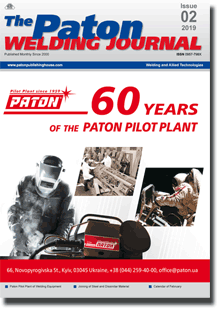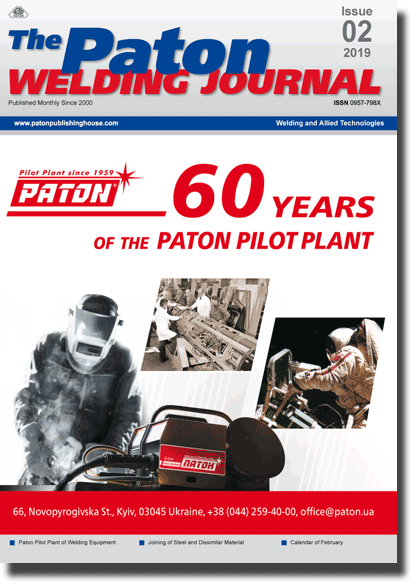Access for download PDF files for subscribers and for reviewers of scientometric bases.
Organization: Elsevier for content access(PDF files of journals released before 2024 are available for download from the website's archives))
Organization: Elsevier for content access(PDF files of journals released before 2024 are available for download from the website's archives))
| 2019 №02 (06) |
DOI of Article 10.15407/tpwj2019.02.07 |
2019 №02 (01) |

The Paton Welding Journal, 2019, #2, 41-48 pages
Journal The Paton Welding Journal
Publisher International Association «Welding»
ISSN 0957-798X (print)
Issue #2, 2019 (March)
Pages 41-48
Heat treatment of welded joints of high-strength railway rails (Review)
R.S. Gubatyuk
E.O. Paton Electric Welding Institute of the NAS of Ukraine 11 Kazimir Malevich Str., 03150, Kyiv, Ukraine. E-mail: office@paton.kiev.ua
In construction of high-speed continuous welded railway lines the high-strength rails, welded by different methods, have a mass application. With the appearance of high-strength rails with a high carbon content, the necessity of implementation of heat treatment operation of butt welded joints in a cycle of rail section manufacture became urgent. The aim of the presented review is the analysis of problems and forecasting the prospects of nowadays technologies of heat treatment of high-strength rail butt welded joints. Different methods of heat treatment used in industry were considered. Different schemes of heating and cooling of rail weld and their effect on formation of microstructure and mechanical properties of joint metal were analyzed. A review of references showed that the technology of high-frequency current heating with further hardening of a head is the most requested during heat treatment of butt welded joints of high-strength rails. 31 Ref., 6 Figures.
Keywords: continuous rail track, high-strength rails, butt welded joints, heat treatment, hardness, microstructure, high-frequency currents, defects
Received: 21.09.18
Published: 11.03.19
References
1. Gromov, V.E., Yuriev, A.B., Morozov, K.V. et al. (2014) Comparative analysis of structural-phase states in rails after volume and differential hardening. Stal, 7, 91–95 [in Russian].2. Voronin, N.N., Prokhorov, N.N., Trynkova, O.N. (2012) Reserves of aluminothermic welding of rails. Mir Transporta, 2, 76–83 [in Russian].
3. Zhadan, G.I. (2012) Assessment of measures on improvement of continuous welded rail track from viewpoint of resourcesaving. Zbirnyk Naukovykh Prats DonIZT, 32, 263–268 [in Russian].
4. Kuchuk-Yatsenko, S.I., Krivenko, V.G., Didkovsky, A.V. et al. (2012) Technology and new generation of equipment for flash-butt welding of advanced high-strength rails for construction and reconstruction of high-speed railway lines. The Paton Welding J., 6, 22–26.
5. Kuchuk-Yatsenko, S.I., Didkovsky, A.V., Shvets, V.I. et al. (2016) Flash-butt welding of high-strength rails of nowadays production. Ibid., 5-6, 4–12. https://doi.org/10.15407/as2016.06.01
6. Kostin, V.A. (2012) Mathematical formulation of carbon equivalent as a criterion for evaluation of steel weldability. Ibid., 8, 11–16.
7. Shtajger, M.G., Balanovsky, A.E. (2018) Analysis of technologies for welding of high-strength rails from position of structure formation in construction and reconstruction of high-speed railway lines. Pt 1. Vestnik Irkutskogo Gos. Tekhn. Un-ta, 22(6), 48–74. [in Russian]. https://doi.org/10.21285/1814-3520-2018-6-48-74
8. Shevchenko, R.A., Kozyrev, N.A., Usoltsev, A.A. et al. (2017) Methods of producing of quality welded joint of railroad rails. In: Proc. of 20th Int. Sci.-Pract. Conf. on Metallurgy: Technologies, Innovations, Quality. Novokuznetsk, SibGIU, 254–257.
9. Tikhomirova, L.B., Iliinykh, A.S., Galaj, M.S., Sidorov, E.S. (2016) Examination of structure and mechanical properties of aluminothermic welded joints of rails. Vestnik YuUrGU. Seriya Metallurgiya, 16(3), 90–95 [in Russian].
10. Kalashnikov, E.A., Korolyov, Yu.A. (2015) Technology of welding of rails in Russia and abroad. Put i Putevoe Khozyajstvo, 8, 2–6 [in Russian].
11. Kozyrev, N.A., Usoltsev, A.A., Shevchenko, R.A. et al. (2017) Modern methods of welding of new generation rails. Izv. Vuzov, Chyorn. Metallurgiya, 60(10), 785–791 [in Russian].
12. Ermakov, V.M., Shtajger, M.G., Yanovich, O.A. (2016) Electronic certificate of rail. Put i Putevoe Khozyajstvo, 4, 13–17 [in Russian].
13. Genkin, I.Z. (2003) Heat treatment of rail welded joints in induction units. The Paton Welding J., 9, 41–44.
14. Saita, K., Karimine, K., Ueda, M. et al. (2013) Trends in rail welding technologies and our future approach. In: Nippon Steel & Sumitomo Metal Technical Report. December, 105, 84–92.
15. Andreeva, L.A., Fedin, V.M., Bashlykov, A.V. et al. (2013) Thermal hardening of rail welded joints in industrial transport. Promyshlennyj Transport XXI Vek, 1, 19–20 [in Russian].
16. Mashekov, S.A., Absadykov, B.N., Alimkulov, M.M., Smailova G.A. (2016) Problems of rail welding and their solution by mean of development of perspective methods of induction welding. Information 1. Dokl. Nats. Akademii Nauk Respubliki Kazakhstan, 305, 19–21, ISSN 2224–5227 [in Russian].
17. Shur, E.A. (2006) Influence of structure on service stability of rails. Influence of properties of metallic matrix on service stability of rails. In: Proc. of 2nd All-Russian Sci.-Techn. Seminar (Ekaterinburg, 16–17 May, 2006). Ekaterinburg, UIM, 37–64 [in Russian].
18. Shtajger, M.G., Balanovsky, A.E. (2018) Analysis of technologies for welding of high-strength rails from a position of structure formation in construction and reconstruction of high-speed railway lines (Review). Pt 2. Vestnik IGTU, 22(7), 41–68 [in Russian].
19. Zaayman, L. (2007) Continuous welded rail using mobile flash butt welding. Civil Engineering, 5, 62–65.
20. (2012) Manual for flash butt welding of rails. Ministry of Railways of India, January.
21. Girsch, G., Keichel, J., Gehrmann, R. et al. Advanced rail steels for heavy haul application – track performance and weld ability Intergrated Project (IP). Thematic Priority 6. Project No. 5: Sustainable Development, Global Change and Ecosystems.
22. Pointner, P., Joerg, A., Jaiswal, J. (2015) Definitive guidelines on the use of different rail grades. Innovative track system, 6, 41–42.
23. Jilabi, Abdul (2015) Welding of rail steels. In: Thesis for PhD Degree, University of Manchester, Faculty of Engineering and Physical Sci.
24. (2015) Continuous path in the United States on the Union Pacific network. Railway Gazette International, 8, 42–43.
25. Gong, L., Zhu, L., Zhou, H.X. (2017) Effect on hardness and microstructures of rail joint with ultra-narrow gap arc welding by post weld heat treatment. Engineering Materials, 737, 90–94. https://doi.org/10.4028/www.scientific.net/KEM.737.90
26. Khlyst, S., Kuzmichenko, V., Khlyst I., Gontar, A. (2013) Experience of conducting of differentiated heat treatment of rails by air method according to the technology «TEK-DT» on industrial unit TEK-DTO-20-13.6. Inzhenernye Resheniya, 1, 1–4 [in Russian].
27. Babenko, P.G., Zeman, S.K. (2002) Software-hardware of automation of technological processes. Tomsk, Tomsk Un-t [in Russian].
28. Feshchukov, A.N., Ruban, V.V., Zeman, S.K. (2013) Complex of high-frequency induction heater for heat treatment of rail welded joints in track conditions. In: 15th Int. Sci.-Pract. Conf. on Modern Engineering and Technologies, 256–258.
29. Rezanov, V.A., Fedin, V.M., Bashlykov, A.V. et al. (2013) Differentiated hardening of rail welded joints. Vestnik VNIIZhT, 2, 28–34 [in Russian].
30. Panteleymonov, E.A. (2018) On the problem of heat treatment of welded joints of railway rails. The Paton Welding J., 3, 36–39. https://doi.org/10.15407/as2018.03.08
31. Mashekov, S.A., Absadykov, B.N., Alimkulov, M.M., Smailova, G.A. (2016) Problems of rail welding and their solution by mean of development of perspective methods of induction welding. Information 2. Dokl. Nats. Akademii Nauk Respubliki Kazakhstan, 305, 22–28, ISSN 2224–5227 [in Russian].
Suggested Citation
R.S. Gubatyuk (2019) Heat treatment of welded joints of high-strength railway rails (Review). The Paton Welding J., 02, 41-48.The cost of subscription/purchase order journals or individual articles
| Journal/Currency | Annual Set | 1 issue printed |
1 issue |
one article |
| TPWJ/USD | 384 $ | 32 $ | 26 $ | 13 $ |
| TPWJ/EUR | 348 € | 29 € | 24 € | 12 € |
| TPWJ/UAH | 7200 UAH | 600 UAH | 600 UAH | 280 UAH |
| AS/UAH | 1800 UAH | 300 UAH | 300 UAH | 150 UAH |
| AS/USD | 192 $ | 32 $ | 26 $ | 13 $ |
| AS/EUR | 180 € | 30 € | 25 € | 12 € |
| SEM/UAH | 1200 UAH | 300 UAH | 300 UAH | 150 UAH |
| SEM/USD | 128 $ | 32 $ | 26 $ | 13 $ |
| SEM/EUR | 120 € | 30 € | 25 € | 12 € |
| TDNK/UAH | 1200 UAH | 300 UAH | 300 UAH | 150 UAH |
| TDNK/USD | 128 $ | 32 $ | 26 $ | 13 $ |
| TDNK/EUR | 120 € | 30 € | 25 € | 15 € |
AS = «Automatic Welding» - 6 issues per year;
TPWJ = «PATON WELDING JOURNAL» - 12 issues per year;
SEM = «Electrometallurgy Today» - 4 issues per year;
TDNK = «Technical Diagnostics and Non-Destructive Testing» - 4 issues per year.


